
How I Optimise My Ferro Rod Pocket Carry
A ferro rod is one of the most essential tools I carry for everyday outdoor fire lighting. Ferro rods are reliable, durable, and consistent fire-starters in a range of conditions. It’s an essential piece of kit. As such they are not just a key part of most modern bushcraft set-ups, they are also a versatile, robust and reliable piece of survival kit.
But how you carry your ferro rod matters. You want it easily accessible when you need it, but also securely fastened so you don’t risk losing it in the field.
In this article I want to walk you through my personal setup for carrying a ferro rod. This makes it quick to deploy, safe from loss, and convenient to store when not in use. Also watch the embedded video for an illustration of the details, including useful knots and fasteners.
Why Stock Ferro Rod Cordage Doesn’t Cut It
Ferro rods are usually supplied threaded onto a short piece of cord, along with a striker to use with the rod. This cord is either knotted into a loop or closed with a plastic clasp. There are several issues with this typical out-of-the-box setup. For starters the plastic clasp fastenings are not secure and should, at least, be removed, binned, and replaced with a knot. But the short length of the cord supplied on most ferro rods is also an issue.
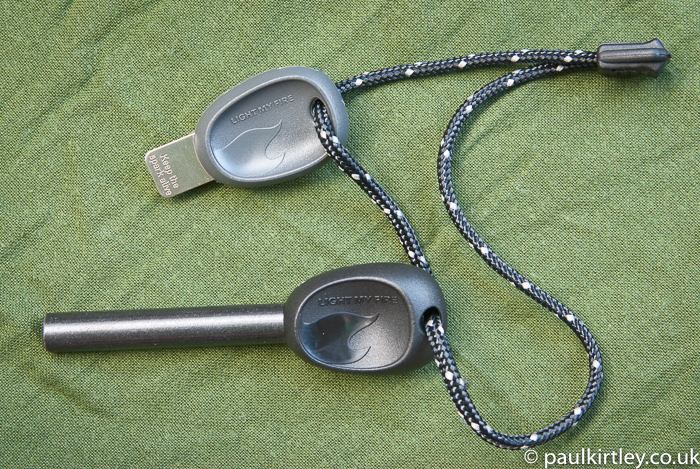
While functional in holding the two key items together, I find the short cord length restrictive. And I have noticed many others do too. One can’t strike the ferro rod freely, especially with a secure grip on the rod.
The other issue with the short cord is that it is too short to attach it to yourself and keep it securely in a pocket. I’ve seen people hang it off a belt or clip, with the rod and striker dangling down the outside of their clothing. In terms of security, this is suboptimal. Hanging the combo like this also makes a lot of noise with the striker and rod clanking together.
So the first thing to do in optimising your ferro rod pocket carry is upgrade the cordage.
Upgrading the Cordage
The simplest and most effective improvement is swapping out that short cord for a longer paracord piece. It gives you more flexibility—literally. The simplest method is to thread both the ferro rod and striker onto the cord, then secure it with an overhand knot. This allows as much freedom in striking technique as you might need. It also allows solid attachment to a belt, using a cow hitch, with the rod and striker sitting deeply in a waist pocket.
However, there’s still a downside. If you’ve attached the setup directly to your belt, you’ll find yourself having to remove the whole thing to use it. This becomes awkward when you’ve got layers on, which is likely in wet or cold conditions.
What Ferro Rods Do I Like For Pocket Carrying?
Check out my article and video on which ferro rods I like (and why). All of these are a good size for a pocket carry.
Adding Quick Release: The Mini Carabiner
To address this, I integrate a mini carabiner into the system, which you can easily pick up in a pack of various sizes online. By including one on the paracord loop, I can now clip and unclip my ferro rod with minimal hassle. It’s a small adjustment but makes a big difference, allowing me to deploy the ferro rod without removing the cord loop from my belt.
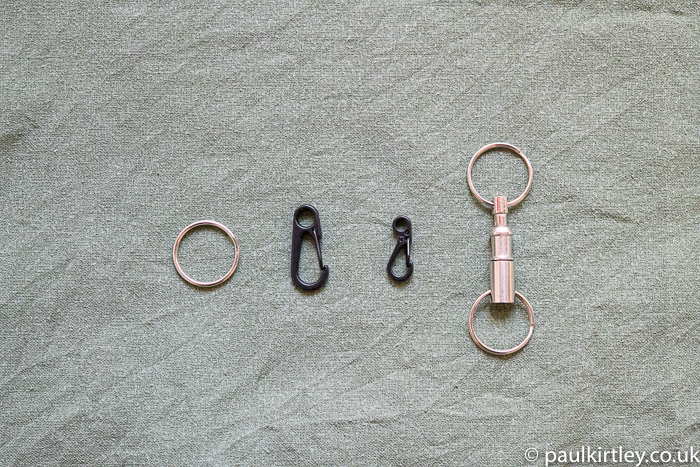
To connect the ferro rod to the mini carabiner, I employ a split ring—the kind you typically see on keychains. When fitting the split ring to the handle of the ferro rod, just be careful not to bend the ring too much. This ensures the ring reverts to its original position and holds the rod securely.
An alternative, as explained in the embedded video below, is a push-clip type of attachment.
Securing Other Pocket Essentials
While the primary focus of this setup is the ferro rod, it makes sense to use the same system to secure other important pocket items. For me, this includes a whistle and a small light.
As far as I am concerned, having a whistle on your person is non-negotiable. It’s an essential item for attracting attention to yourself when lost or injured. The Fox 40 whistle is a great choice.
Having even a small light source on hand such as a Photo Micolight, can be very useful in low light conditions. The batteries last a long time. But the light doesn’t travel very far. An alternative is a very bright, yet still relatively compact Olite Baton-type flashlight. These powerful little flashlights can make all the difference in finding your way in darkness.
To attach a Microlight, thread it directly onto the paracord loop. A whistle might also be threaded directly onto the cord, but otherwise a split ring can be employed to attach it to the cord. Similarly with a Baton-type flashlight, I put a small split ring on the lamp, then clip this onto a second clip on the cord loop. A second clip can also be used to attach other important items instead, such as a key.
The result is a streamlined system where all the essentials are in one place, easily accessible yet securely fastened.
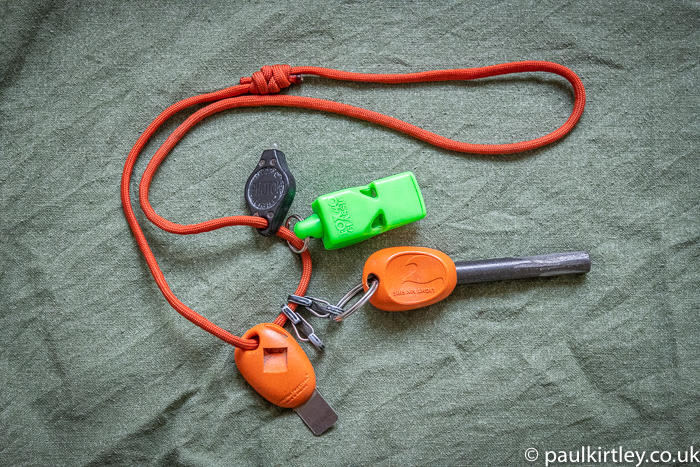
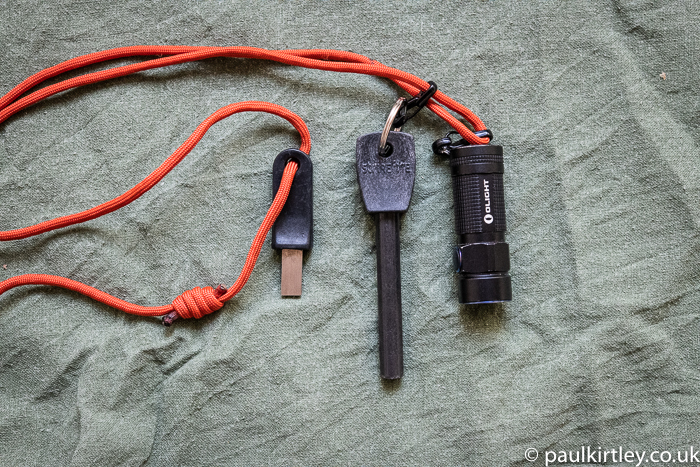
Once you have put everything onto the cord, you should close the cord loop with a knot that will not loosen over time. The simplest method is an overhand knot. A single fisherman’s knot will work well too. For fixed loops on lanyards, however, my favourite knot is a double-fisherman’s knot. I find the latter particularly aesthetically appealing because you can reduce the tails of the cord to a very short length, resulting in an extremely tidy knot. This helps keep the setup neat and organized.
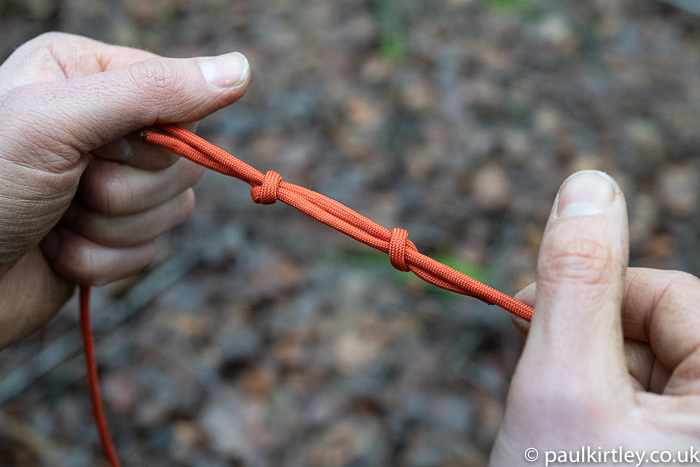
Watch The Video On My Ferro Rod Pocket System
Why This Ferro Rod Attachment Setup Works
This setup offers speed, security, and convenience. With the mini carabiner in place, I can quickly remove the ferro rod for use, then just as easily clip it back when I’m done. No need to mess about with untying knots or unlooping cords.
As well as allowing easy access to the ferro rod, this setup minimises the friction of stowing your gear too. This is crucial in the field. All too often I see inexperienced people placing their ferro rod, lighter or match box on the ground immediately after ignition, while they then tend to their nascent fire. This sloppiness increases the chances of losing a critically important item.
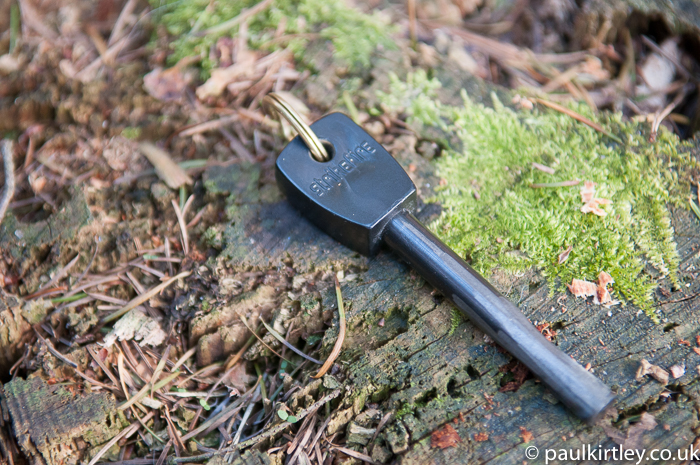
Plus, by keeping the ferro rod and other essential items like the whistle and microlight on the same loop, you reduce the likelihood of losing anything important. It’s all attached, organised, and with the paracord, you’ve got the added bonus of having spare cordage on hand should you need it in an emergency.
Additional Tweaks
Some folks find the ferro rod striker edges a bit harsh when keeping it in their pocket. This is due to the burr on the striker which creates more purchase on the ferro rod when striking. The burr can be quite sharp on the edge, and the concern is that this might damage pocket linings over time. A quick solution is to wrap the striker in duct tape. This covers any burrs that might otherwise damage your clothing or other gear. This solution makes most sense when you are not regularly using the striker but carrying it for back-up. Many of us prefer to use the squared-off back of a knife to strike a ferro rod, including this technique for creating large sparks with a ferro rod.
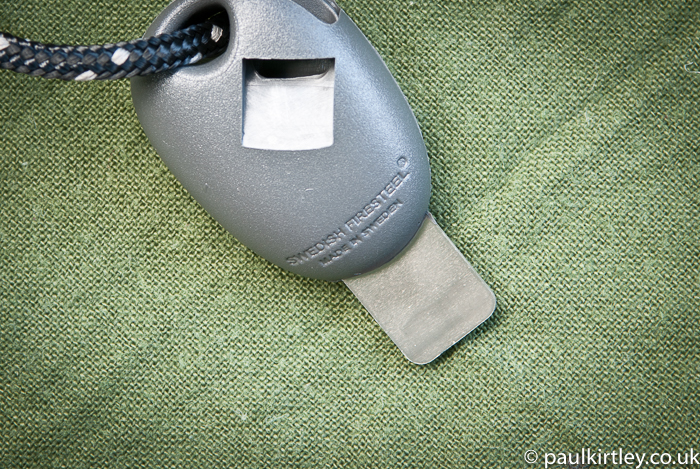
Another tip is to always carry at least one additional fire-starting method with you. While I rely on my ferro rod most of the time, having a backup is good practice in case conditions become difficult or your primary method fails. A Bic lighter in an Exotac Firesleeve, matches in a waterproof matchsafe such as the Exotac Matchcap, or both, are excellent additions to your fire-lighting arsenal.
Final Thoughts On My Ferro Rod Pocket Carry System
This ferro rod setup is one I’ve refined over time. It is based on my time spent in the woods, teaching bushcraft courses, running wilderness expeditions, and undertaking my own back-country trips. This simple yet effective system is quick, easy, and—most importantly—secure. Whether you’re heading out on a day hike or embarking on a longer wilderness trip, I highly recommend taking the time to optimize how you carry your ferro rod.
If you’ve any thoughts or alternative setups that work for you, I’d love to hear about them in the comments below. It’s always interesting to exchange ideas and learn from others’ experiences.
Useful Gear For A Solid Pocket Carry Set-up
Standard (“Army”) size Ferro Rod and striker (ideal for pockets)– Strikefire: https://amzn.to/47sYFrY– Light My Fire: https://amzn.to/3XvRxYh550 paracord https://amzn.to/3TC8AXuMini carabiners https://amzn.to/3TEuKbpFox 40 Whistle https://amzn.to/4evCEfsIllumination (small)– Photon Microlight https://amzn.to/3zsQ1xV– Olite Baton https://amzn.to/3ZstVq1Push-release keyring clips https://amzn.to/3BmprqJOther pocket carry fire gear– Bic lighters https://amzn.to/3XCloOu– Exotac Firesleeve https://amzn.to/3XGU3eq
Related Material On This Site
The Best Ferro Rod? Insights From My Experience
The Value Of Visibility: Considering The Colour Of Critical Kit
Getting Started With Bushcraft: Kit Considerations For Beginners
Essential Wilderness Equipment – 7 Items I Never Leave Home Without
#AskPaulKirtley 82 – The Changes In My Bushcraft Philosophy, Rubbish Firesteels, and Book Writing
PK Podcast 028: Joe Robinet On His Love Of Camping, Bushcraft & Making A Living On YouTube
12 thoughts on “How I Optimise My Ferro Rod Pocket Carry”
I tend to fit a little clip, like the ones pictured, to the split-ring and then clip the individual items on to a lanyard. This allows additional versatility. I like a lanyard with two loops and tied with a double fisherman’s knot in the middle; lay the length of cord out in an ‘S’ and tie each half of the fisherman’s knot around each ‘pair’ of parallel strings if you see what I mean. This allows for adjustment to the length of the loop on each side. You can choose to wear things around your neck (where it’s safe to do so) or loop it around your belt as circumstances dictate.
Hi there!
You hit on a pet peeve of mine and I thought I would share. As a wilderness whitewater canoeist in Canada (50+ years ), I have used safety whistles in earnest and most can’t be heard beside a rapid river. The Fox 40 has got a history, but is not loud enough to be depending on it. I would suggest looking into the “Storm Safety Whistle.” This unit will hurt your ears when you blow it. I know… but that means it will travel. I tested a number of whistles after having a number of fails in real ditch situations (including the Fox40) a couple of years back. If one is deciding on a piece of safety gear (especially one that is so inexpensive, but critical), the same consideration should be taken as for other gear. (I receive nothing for this recommendation, btw)
Hi Stephen,
Thanks for taking the time to share this experience. I appreciate it. I will get hold of some Storm Safety Whistles.
Yours in paddling.
Paul
Hey Paul,
Thank you for sharing your way of carrying small items such as a mini flashlight, firesteel or a small knife for example.
In the case of Firesteel, the first thing what I always do, is remove the usually short cord and replace it with a 3-millimeter elastic cord. This allows me to work with it without the need of carabiners or knots or having to let it and leave the scraper and the Firesteel itself separate, even if only for a short moment.
It is a simple, cheap and effective solution.
After my years in the army in an airborne unit, I have become accustomed to having all the small things or items that I usually carry in my pockets, such as a flashlight, folding knife, firesteel when I am at outdoors, wallet, etc., always tied with different cords attached to belt loops or directly to the belt, using small clips or carabiners similar to yours but made of plastic, so they don’t make noise.
When I carry a small pocket knife or a Victorinox in my pocket outdoors, I use the same short cord with a carabiner on my belt that I copied from you years ago in one of your blog posts. This way the knife doesn’t get lost in the bottom of my pocket, and is easily located with one hand.
Regards.
Stephan.
Thanks for your positive words Stephan and for sharing your perspective on this topic. It’s much appreciated.
Warm regards,
Paul
I use a clip system like yours for my flash light and whistle etc but these days I have a separate spring loaded retractable lanyard for my fire steel. It means if I want to immediately use my hands for tending my fire in tricky conditions, I can just “drop” the fire steel with no risk of losing it or it snagging on things or getting in the fire as it might if it was attached to me by a long strong. I then automatically tuck it back in my pocket when I stand up because it’s swinging around close to my belt and bugging me!
I can still easily unclip it if needed and if the spring fails in the field (hasn’t in 7 years of daily use but I’m sure it will eventually) I can just transfer the steel to the “normal” clip until I have time to buy a replacement.
Hi Craig,
Thanks for your comment. I quite like the idea of your retractable cord (sounds like what a lot of people use for ski passes). This makes sense and I’m glad you have a system that works well for you. I also appreciate you sharing some data on the reliability and longevity of the spring system, as that would have been a concern of mine otherwise. It’s good to know it has lasted.
Warm regards,
Paul
It’s exactly the ski pass style! As it’s worn around the waist and retracts back out of the way after use, it’s not prone to getting dirty which I suspect is why it’s lasting so well despite being party of my daily work wear.
Hi Paul – just a heads up – the affiliate link to the Strikefire goes to the mini carabiners.
Cheers
Hi Andy, thanks for the heads-up. I’ll get that sorted.
Cheers,
Paul
Hi Paul
I’ve been using your system since I saw the video of it. One slight difference is that I have the hook on the items (rather than fixed to the paracord) and then clip them onto the cord. I found that clips detached a bit too easily from small split rings when in my pocket. Also means I can easily clip up the led light or torch in my hammock etc if needed. I keep a small led keyring light on it when the days are longer and swap over to a small more powerful torch when the days are a shorter.
All the best,
Stu
Hi Stu, it’s good to hear from you and thanks for sharing your variations. I particularly like the idea of the clip being on the microlight so it can be clipped onto a hanging line under a tarp. I might have to try this.
All the best,
Paul